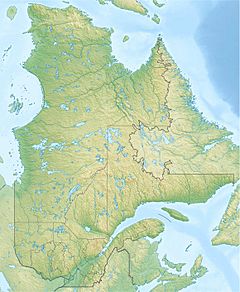Saint-André River facts for kids
Quick facts for kids Saint-André River |
|
|---|---|
| Native name | Rivière Saint-André |
| Country | Canada |
| Province | Quebec |
| Administrative region | Chaudière-Appalaches |
| RCM | Lotbinière Regional County Municipality |
| Physical characteristics | |
| Main source | Agricultural streams Saint-Sylvestre 297 metres (974 ft) 46°21′56″N 71°13′10″W / 46.365491°N 71.219533°W |
| River mouth | Filkars River Sainte-Agathe-de-Lotbinière) 161 metres (528 ft) 46°23′52″N 71°19′22″W / 46.39778°N 71.32278°W |
| Length | 12.5 kilometres (7.8 mi) |
| Basin features | |
| Progression | Filkars River, Beaurivage River, Chaudière River, St. Lawrence |
| Tributaries |
|
The Saint-André River (called rivière Saint-André in French) is a small river in Quebec, Canada. It's like a smaller stream that flows into a bigger river called the Filkars River. From there, its water joins the Beaurivage River, then the Chaudière River, and finally reaches the mighty St. Lawrence River.
This river flows through two towns: Saint-Sylvestre and Sainte-Agathe-de-Lotbinière. Both of these towns are in an area known as the Lotbinière Regional County Municipality, which is part of the Chaudière-Appalaches region in Quebec.
Contents
Where Does the Saint-André River Flow?
Understanding the River's Journey
The Saint-André River is part of a larger system of rivers. Think of it like branches on a tree, where each branch collects water and sends it to the main trunk. The area of land that collects water for a river is called its watershed.
The Saint-André River's watershed is surrounded by other important river systems. To the north, you'll find the Fourchette River, the Filkars River, and the Beaurivage River. To the east are the Beaurivage River, Nadeau River, Lessard River, Vallée River, and the Chaudière River.
To the south, it's near the Filkars River, Palmer River, and Palmer East River. On the west side, you'll find the Armagh River, Saint-Georges River, rivière du Chêne, and Henri River.
Starting Point of the River
The Saint-André River begins its journey in the town of Saint-Sylvestre. Its very first drops of water come from agricultural streams. This starting point is about 0.6 kilometers (or about half a mile) east of the center of Saint-Sylvestre village.
The source is located south of Route 216, a main road. It's also north of a place called Mont Handkerchief and south of the village of Saint-Patrice-de-Beaurivage.
How Long is the Saint-André River?
From where it starts, the Saint-André River flows for about 12.5 kilometers (which is about 7.8 miles). It takes a winding path through the landscape.
Here's how its journey unfolds:
- For the first 0.4 kilometers, it flows northeast. It then crosses Route 216.
- Next, it travels 2.4 kilometers, first northeast, then west. It crosses Moulin road.
- It then flows southwest for 3.2 kilometers within Saint-Sylvestre, where another small stream joins it.
- After that, it goes northwest for 1.4 kilometers, reaching Route 269.
- The river continues northwest for 4.4 kilometers, reaching the border of Sainte-Agathe-de-Lotbinière. It flows along this border for about 300 meters.
- Finally, it flows northeast for 0.7 kilometers until it meets the Filkars River.
Where the River Ends Its Journey
The Saint-André River eventually flows into the south bank of the Filkars River. This meeting point is in the eastern part of Sainte-Agathe-de-Lotbinière. This spot is about 2.7 kilometers upstream from where the Filkars River itself joins an even larger river.
What's in a Name?
The name "rivière Saint-André" was officially recognized on December 5, 1968. This was done by the Commission de toponymie du Québec, which is like a special committee in Quebec that names places.


